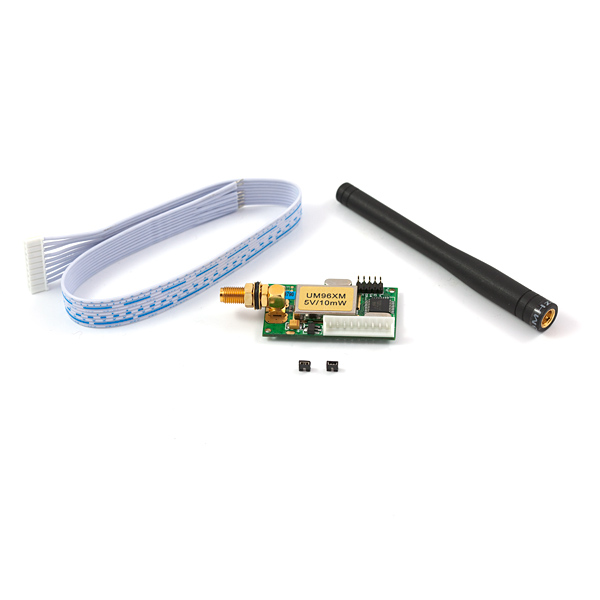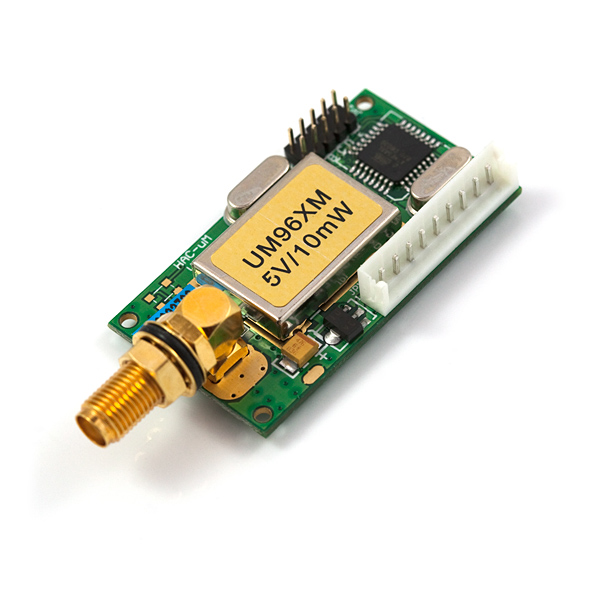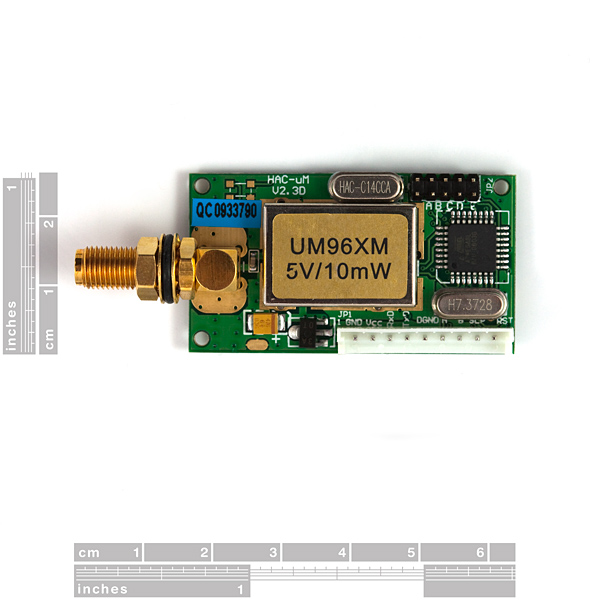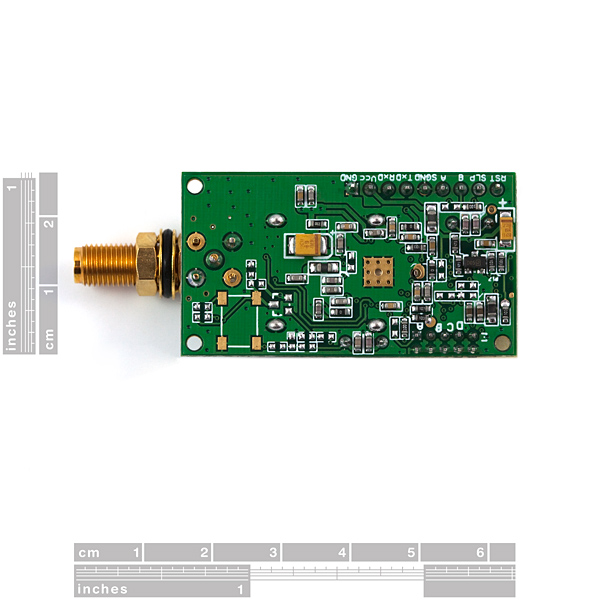×
SparkFun will be closed on Tuesday, December 24th, and Wednesday, December 25th, in observance of the Christmas holiday. Any orders qualifying for same day shipping placed after 2:00 p.m. (MST) on Monday, December 23rd, will be processed on Thursday, December 26th, when we return to regular business hours. Wishing you a safe and happy holiday from all of us at SparkFun!
Please note - we will not be available for Local Pick up orders from December 24th-December 27th. If you place an order for Local Pick-Up we will have those ready on Monday, December 30th.
Modem Long Range 433MHz: UM96 - Includes Antenna and Cable
433MHz Long Range Radio from HAC. These small modems use a seamless serial interface - whatever enters the TX pin at 9600bps shows up on the other unit's RX pin. All buffering and error detection is handled internally. And the best part - with 10mW output, it reaches over 500m!
This unit can be attached to TTL level serial (for microcontrollers) or directly to RS232 for incredibly simple serial cable replacement!
Specifications:
- Operating Voltage: 3.3V-5.5V
- 9600bps over 500m
- Modulation type: GFSK
- 8 Channels jumper selectable
- Low power : 30mA RX, 40mA TX, 20uA Sleep
- Small footprint size: 26x47mm
Supported Antennae: Kit comes with 1/4 wave 50Ohm antenna and communications cable!
Sold in single units.
HAC-UM96 Datasheet (this is a difficult datasheet to read)
- Tutorial and Translated manual by Dimitri Karatsinides
Modem Long Range 433MHz: UM96 - Includes Antenna and Cable Product Help and Resources
Core Skill: Soldering
This skill defines how difficult the soldering is on a particular product. It might be a couple simple solder joints, or require special reflow tools.
Skill Level: Noob - Some basic soldering is required, but it is limited to a just a few pins, basic through-hole soldering, and couple (if any) polarized components. A basic soldering iron is all you should need.
See all skill levels
Core Skill: Electrical Prototyping
If it requires power, you need to know how much, what all the pins do, and how to hook it up. You may need to reference datasheets, schematics, and know the ins and outs of electronics.
Skill Level: Rookie - You may be required to know a bit more about the component, such as orientation, or how to hook it up, in addition to power requirements. You will need to understand polarized components.
See all skill levels
Comments
Looking for answers to technical questions?
We welcome your comments and suggestions below. However, if you are looking for solutions to technical questions please see our Technical Assistance page.
Customer Reviews
No reviews yet.





Every time a 433 MHz product is sold, there seems to be at least one AARL messenger saying that it can't be used. Well, that's dead wrong. I feel I need to build on a comment I made previously.
Anyway, if you are operating this device away from any 70cm HAM stations, nobody is even going to know. Even if there is a HAM operator nearby, they blast so much power and need so much SNR that they still won't likely notice. Furthermore, I've been building 434 SRD devices for years, I've never noticed much activity from HAMs inside the Region 1 434 ISM band, and I work in a place where there are a lot of HAM operators.
Also be aware, the base frequency of this unit is in the amateur radio 70cm band is reserved for Auxilliary repeater inputs.
Can this thing handle 6v (4x AA batteries)? I'm struggling to find a power source that will work for this and a Pololu Maestro board (whch needs 5v).
Any idea when this is coming back in stock?
Will this item work to transmit a USB signal (and is there an adapter cable, or I'd need to wire it myself)? OR do I need a different item, say https://www.sparkfun.com/products/9034 ? I want to transmit the USB output from a device like the Hauppauge USB-LIVE 2 (www.amazon.com/Hauppauge-610-USB-Live-Digitizer-Capture/dp/B0036VO2BI).
How long is the antenna? 1/4 wave should be 17.3cm and it definitely does not look that long on the photo. Coiled inside?
I just received the item, and the black plastic antenna housing is exactly 10 cm length. It rattles a bit, indicating the physical (metal) antenna is loose inside, but I don't see a way to open the black housing.
How orientation sensitive are these? Obviously it will depend on what kind of antenna you use, but what's it like with the one it comes with?
Can anyone speak to distance? How far can two of these units be from each other? I saw the datasheet said 300m-500m when in line of sight. True/false?
10mW output is not a load power, but a lot of it can depend on your antenna. If you use the crappy ducky antennas, you won't go very far... but get yourself a whip antenna made from a piece of wire, and a couple of ground radials, or even a yagi style beam, and you've gained LOADS of distance. Depends on your use what kind of radiation pattern you want.
"70cm" band covers 420-470 in USA. HAMs generally stay away from 433.05-434.79 ISM band. They have the rest of the 50 MHz (and technically you do too). That said, 10mW is too much radiated power even still, but no-one is going to find you.
Based on the floorplan, looks like a CC1101 transceiver, BTW. Using that part at 10mW you should be able to get over 1km, at 9600bps, with a decent antenna. Especially if you hack it to use wideband FSK instead of narrowband as I assume is the case.
It would be nice if you guys DID have some ham band(s) (and power) things. Guess I could make a amp for this to give it a nice 1w, that should do a few miles with a better antenna, long distance RC plane, yea. There really are no 70cm repeaters in my area (only one I think.)
Check Flytron product, they have 7W Amplifier for that frequency!
I bought a few of these and powered them up. The /SLEEP and /RESET pins have been pulled high per the manual. Parity is 8n1 for each and each modem is set to 433.9260 via the jumper. When I plug the radios in I get a readout displaying "uM96v2.31AXM" but after then when I transmit, nothing goes through. Do any of you guys have the same problem?
Anything notated as /SLEEP or /RESET means active low. If you're pulling it high it's both in sleep and reset.
I am getting the same serial output on powerup and no serial transmissions. On both UM96, I have pins 1&5 grounded, pins 2&9 at +5v, pins 3&4 not connected, pin 6 goes to my 5v PIC serout, pin 7 goes to my 5v PIC serin, and Sleep pin 8 is grounded. Jumpers A,B,C are open, D connected for RS232, and E connected for 8N1 no parity. When I power up my receiving UM96, it outputs “uM96v2.31AXM” characters at 9600bps. But when I try to send 9600bps text records via RF, nothing happens. I notice that both unit draw about 28ma when powered, but I do not see any increase in power draw when the transmitter should be sending. Any suggestions?
was you being serious when you said it was difficult to read? Its like 5 pages and is as simple as learning PWM.
These units operate under part 15.231 of the FCC regs which authorizes Intermittent Control Signals and/or Periodic Transmissions from 410 to 512 MHz. Shared usage is not unusual on many of the ham bands. Read the regs.
Rye K9LCJ
Considering the manufacturer offers a wide choice of frequencies, it seems odd to select one that is not suitable for continuous use.
Do you have anything like this that is legal for use in the USA? ;-) Say 315 or 418 MHz?
Be aware that sleep mode is enabled on these devices, so remember to pull the SLEEP pin to ground if you do not want to use it!